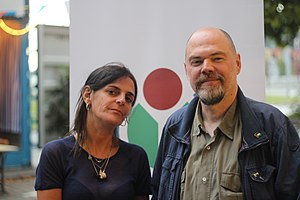La Cérisaie: a performance that feels like a workshop might need a director!

The Cherry Orchard
A TG Stan production, NAC French theatre
There are probably few plays as challenging, thrilling and intriguing for
artists as The Cherry Orchard. It’s been a little over a century that theater directors have been trying to decide whether it is a tragedy, comedy, or something in between. Anton Chekhov himself intended to write a comedy, but Konstantin Stanislavski, who was the first director to put the play on stage in 1904 in Moscow believed it to be a tragedy. So, it’s been more than 100 years that one of the greatest dramas by one of the greatest playwrights of all time keeps changing genre and mood, and being interpreted and reinvented by numerous theater artists all over the world.
of those whose lives revolve around it unfold. The minimalistic set,
consisting of a few panels, a big table and a few stools, is a perfect
setting that shifts the focus on play’s symbols and the depth of its
meaning. Wisely-chosen costumes define personalities and underline the timeless nature of the play. Light depicts the passing of time through day and night, and the music is just right for the mood of the moment.
Making them relevant today is definitely the best way to reach young audiences. STAN’s interpretation of Chekhov is fresh, lively and energetic. It speaks to all of us, young and old. STAN boasts that they direct their plays as a collective, so, no director. That is not a bad approach by itself, unless it leaves a thing or two unresolved. Could that be the problem the Belgian troop faces? Maybe a cohesive direction is the missing element?Although all elements of the play are good and well executed, from time to time there is a feeling that the play resembles more a workshop that a serious, well-rounded show. There are two major reasons for that. The first problem is the transitions, which are often too fast. As a result, the more subtle feelings and messages are lost. This leaves the audience untouched. The prevailing tone is too casual to reach very far. Do these people feel anything? Are they really frustrated, worried, in love, or do they say that they feel so just for saying’s sake? It is hard to tell.
Actors do not allow the necessary time or space to answer those questions. Additionally, there are scenes where the connection between characters is completely missing. For instance, there is a disconnect when the daughter Anja is trying to console her mother, while she makes eye contact solely with someone in the audience. Regardless of the approach – modern, classic or experimental – to create an atmosphere or reality, actors should stay connected at all times and on all levels, eye contact included.Changing the set in which everybody takes part, does not help, either. Often it is too long and overall disruptive. The introduction of light comedy during these changes does a disservice to the playwright. “The Cherry Orchard” might be a comedy, but it is not a light one. Actually, it is anything but that. There is a depth and heaviness in this play – the reason why it is seen by some as a tragedy – so that introducing light entertainment in it, downgrades the play.
STAN’s version of The Cherry Orchard has a lot to be admired – excellent acting, vision, and great energy. Still, with good direction, it might be a much better performance. Whether they need a director, or just broader knowledge and more directing experience – it is for them to decide.
Written by Anton ChekhovTG STAN